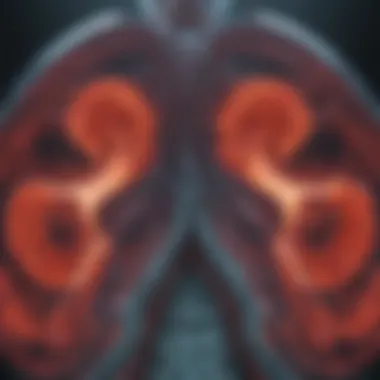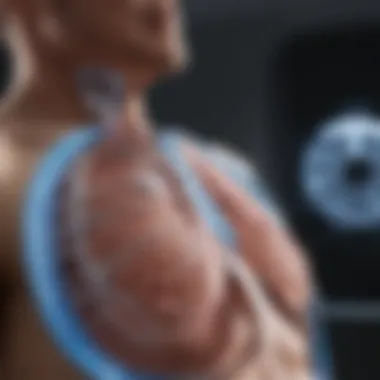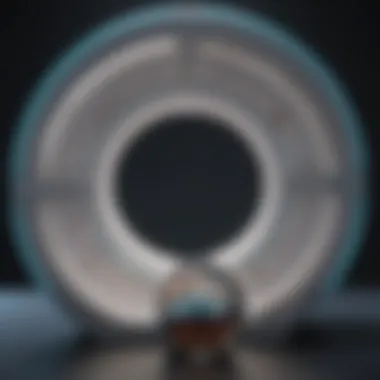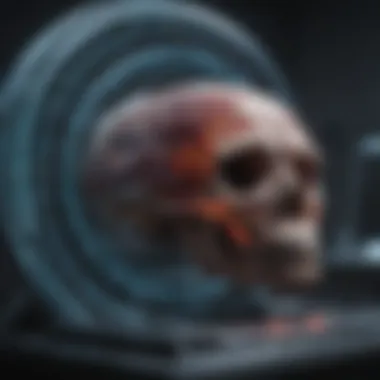Guidelines for PET CT in Lung Cancer Management


Article Overview
Lung cancer remains one of the most significant health concerns worldwide, presenting complex challenges in diagnosis and treatment. In this context, the role of PET CT scans has grown to be pivotal, offering a window into the physiological and metabolic processes within tumors. The purpose of this article is to systematically explore the guidelines surrounding the use of PET CT imaging in lung cancer, providing vital insights for healthcare professionals navigating this intricate disease.
Summary of Key Findings
- Role of PET CT: PET CT imaging provides a dual benefit by combining anatomical and functional imaging, which aids in accurately staging lung cancer and assessing treatment efficacy.
- Criteria for Use: Guidelines emphasize specific scenarios in which PET CT should be employed, such as initial staging, restaging after treatment, and monitoring disease progression.
- Clinical Implications: The results obtained from PET CT scans significantly influence clinical decision-making, informing treatment plans and improving patient outcomes.
Research Objectives
This article aims to delve into the multifaceted aspects of PET CT guidelines, focusing on:
- Understanding the technicalities of PET CT imaging and its relevance in lung cancer.
- Outlining the criteria for its use during various stages of the disease.
- Analyzing treatment response assessment via PET CT.
- Discussing current protocols along with limitations.
- Synthesizing the implications of PET CT findings on existing treatment frameworks.
Key Results and Discussions
Main Findings
Recent studies have shown that PET CT can significantly enhance the accuracy of lung cancer diagnoses when compared to traditional imaging methods alone. For instance, a study might point out that PET CT detects smaller lesions that might be missed by X-rays or CT alone. This not only helps in the initial identification of cancer but also in differentiating between benign and malignant nodules.
"PET CT has emerged as a cornerstone in lung cancer management, illuminating diagnostic pathways and ensuring tailored treatment strategies."
- Staging Lung Cancer: The guidelines stipulate the use of PET CT in assessing the stage of cancer, particularly for non-small cell lung carcinoma (NSCLC). It can delineate the extent of disease spread, which is crucial for selecting the appropriate treatment plan.
- Treatment Response Assessment: Post-treatment imaging via PET CT is essential for evaluating how well therapies are working. The uptake of a radioactive tracer can reveal metabolic activity that persists after conventional treatments.
Implications of Findings
The integration of PET CT into clinical practice carries substantial implications:
- Enhanced Decision Making: Access to detailed imaging results leads to more informed decisions regarding surgery, chemotherapy, or radiation therapy.
- Potential Limitations: However, practitioners must also weigh the limitations of PET CT, such as false-positive results due to inflammatory processes, which can misguide treatment decisions.
Prelude to Lung Cancer
Lung cancer remains one of the most pressing health challenges today, affecting countless lives across the globe. Understanding the complexities surrounding lung cancer is essential for healthcare professionals, educators, and researchers alike. This introductory section serves as an essential backdrop to the guidelines for using PET CT in lung cancer management.
The epidemiology of lung cancer provides critical insight into its prevalence, aiding in strategic public health initiatives. Without a grasp of how common and what types of lung cancer we face, any clinical approach risks missing the mark.
In addition, the clinical significance of early diagnosis cannot be overstated. Early detection is often the key to better outcomes in treatment and management. Recognizing the disease in its initial stages can dramatically influence treatment options, extend patients' lives, and improve quality of life. This section will highlight the relevance of lung cancer awareness and early intervention, which sets the stage for the discussions to follow on PET CT imaging, its applications, and the necessary guidelines.
Epidemiology of Lung Cancer
Lung cancer does not discriminate; it strikes people from all walks of life. According to recent data, lung cancer remains the leading cause of cancer-related deaths globally. The landscape of lung cancer is variable, greatly influenced by factors such as geographical location, smoking prevalence, and even occupational hazards. For instance, studies indicate that in regions where tobacco use is rampant, the incidence of lung cancer is markedly higher.
Factors that contribute to lung cancer incidence include:
- Smoking: This is by far the most significant risk factor, accounting for approximately 85% of lung cancer cases.
- Environmental Factors: Exposure to radon, asbestos, or other carcinogens also plays a crucial role.
- Genetics: A family history of lung cancer might increase one's risk, pointing to a possible hereditary component.
The statistics can be staggering. For instance,
"The Global Cancer Observatory estimates more than 2 million people are diagnosed with lung cancer annually."


It’s crucial for practitioners to remain aware of these patterns when assessing risk factors in patients, leading us to early diagnosis approaches.
Clinical Significance of Early Diagnosis
In the realm of lung cancer, time is of the essence. Catching lung cancer early can transform the treatment landscape. Patients diagnosed at an early stage often have more options available, often resulting in better survival rates and improved quality of life. Lung cancer found at an advanced stage, however, may only offer limited treatment avenues.
The significance of early diagnosis lies in several key aspects:
- Increased Survival Rates: Early-stage lung cancer is often treatable through surgery and sometimes, targeted therapies.
- Lower Treatment Costs: Managing a disease in its early stages can be less resource-intensive than treating advanced forms.
- Psychological Impact: Early detection can improve the mental wellbeing of patients who may face the unknown with a clearer, more manageable treatment plan.
As we progress into the next sections of this article, we will deeply examine how imaging technologies like PET CT fit seamlessly into this picture, playing an instrumental role in both the detection and ongoing management of lung cancer.
Understanding PET CT Imaging
The role of Positron Emission Tomography Computed Tomography, better know as PET CT, has become increasingly pivotal in oncology, especially concerning lung cancer. This imaging technique converges two powerful modalities: the metabolic information from the PET scan and the anatomical detail from the CT scan. By merging these aspects, PET CT delivers a fuller picture that aids clinicians in making informed decisions about patient management. The comprehension of PET CT imaging not only enhances diagnosis but also optimizes therapeutic direction; it is vital for healthcare professionals dealing with lung cancer.
Technological Overview
At its core, PET CT utilizes a radiotracer, generally fluorodeoxyglucose (FDG), which is injected into the patient’s bloodstream. The cells that are highly active metabolically, such as cancer cells, absorb more of this tracer.
- FDG Uptake: The way cancer cells absorb FDG can be quantified and is indicative of tumor behavior.
- Image Acquisition: After a waiting period, patients undergo a CT scan followed immediately by a PET scan. The integration of these scans allows for accurate localization of cancerous regions within the lung.
- Data Processing: Complex algorithms merge the images into a single comprehensive dataset that enables clinicians to visualize structures and metabolic activity simultaneously.
This sophisticated technology forms the backbone of effective lung cancer diagnosis and treatment planning.
Advantages of PET CT in Oncology
Adopting PET CT in the oncological setting brings forth several advantages:
- Early Detection: PET CT can identify cancerous changes often before they are visible on conventional scans. This early detection can significantly affect treatment outcomes.
- Staging Accuracy: The clarity and detail provided by PET CT help in accurately staging lung cancer, aiding in determining the extent of disease spread, which is critical for planning treatment.
- Monitoring Therapeutic Response: Frequent use of PET CT allows oncologists to assess how well a treatment is working, enabling timely adjustments in therapy if necessary.
- Reduced Need for Invasive Procedures: By providing clear images and physiological information, PET CT can sometimes eliminate the need for biopsy, reducing patient discomfort.
As noted, "The ability to see both function and structure is tremendously useful for oncologists navigating complex cases."
Limitations and Challenges
Despite its many advantages, PET CT is not without limitations. Understanding these constraints ensures that healthcare providers employ this imaging modality judiciously:
- False Positives: Not all areas of high FDG uptake are cancerous, which can lead to unnecessary anxiety and invasive follow-up procedures.
- Limited Resolution: Small tumors may not always be detectable, especially when they are in early stages or located in complex anatomical regions.
- Cost Considerations: The financial implications of PET CT can be significant, and accessibility may be limited in certain regions or health systems.
- Radiation Exposure: While the amount of radiation is generally low, cumulative exposure remains a consideration in longitudinal imaging, particularly in young patients.
In summary, while PET CT is an invaluable tool in the fight against lung cancer, the nuances of its operation and the potential pitfalls demand careful navigation. A robust understanding of its functioning, advantages, and limitations paves the way for judicious application and better patient outcomes.
Clinical Application of PET CT in Lung Cancer
The integration of PET CT imaging in lung cancer treatment heralds a paradigm shift in the clinical landscape, emphasizing the necessity of accurate, timely assessments. For oncologists and healthcare providers, understanding these applications is key. PET CT serves not just as a diagnostic tool but also as a comprehensive guide that influences treatment strategies and outcomes. This section explores three principal areas where PET CT significantly impacts lung cancer care: staging, treatment response, and recurrence evaluation.
Staging Lung Cancer with PET CT
Staging is a crucial aspect of managing lung cancer as it determines the extent of the disease and informs treatment decisions. Traditional imaging techniques, like CT scans, often leave gaps in detecting metastases, ultimately leading to suboptimal treatment planning. PET CT, however, shines in this context. By combining the anatomical detail from CT with the functional insights from PET, this imaging modality allows for a more accurate representation of tumor biology.
For instance, in identifying advanced disease, PET CT can highlight active metastases that might otherwise go unnoticed. It can differentiate between benign and malignant lesions with greater precision, offering oncologists a clearer picture.
Furthermore, > "The use of PET CT in initial staging significantly increases the sensitivity and specificity of detection, leading to improved patient management strategies." Recognizing these nuanced details assists healthcare professionals in tailoring treatment plans, potentially improving outcomes for patients.


Assessing Treatment Response
After initiating treatment, it’s vital to evaluate how well the cancer is responding. Here, PET CT plays a pivotal role. Unlike conventional imaging, which might show physical changes in tumor size, PET CT offers insight into metabolic changes. This distinguishes it as a valuable tool for early detection of treatment efficacy.
In practical terms, oncologists use PET CT to assess whether the metabolic activity of the tumor decreases, implying a positive response. For example, a marked reduction in FDG uptake not only hints at shrinkage but also suggests that the cancer cells are becoming less active. This allows for timely treatment adjustments, optimizing the therapeutic approach based on real-time information.
Evaluating Recurrence
Monitoring for recurrence post-treatment is another critical application of PET CT in lung cancer management. Unfortunately, the specter of recurrence always looms over former patients. PET CT is remarkably sensitive in this regard; it can detect recurrences even when they are not yet visible on other imaging modalities.
Health professionals often rely on PET CT to identify unsuspected nodules or lymph nodes in patients who have previously been treated. This capability plays a crucial role in establishing any necessary follow-up treatments or additional interventions. By effectively identifying recurrences, the healthcare team can implement timely strategies, potentially improving the patient’s prognosis.
In summary, the application of PET CT in lung cancer’s clinical management is multifaceted, providing essential tools for staging, assessing treatment response, and evaluating recurrence. With each scan, this technology enhances our understanding and approach to lung cancer, fundamentally shifting how we manage this challenging disease.
Guidelines and Protocols for PET CT Use
When it comes to the fight against lung cancer, guidelines and protocols for PET CT use serve as a compass. They guide healthcare professionals through the intricate landscape of imaging, ensuring that all steps taken are deliberate and well-informed. Having established guidelines is crucial for standardizing practices across different clinical settings. These protocols not only enhance the consistency in patient care but also improve accuracy in diagnosis and treatment assessment.
Established Guidelines
Understanding established guidelines is key for any practitioner involved in lung cancer care. Various health organizations, including the American College of Radiology (ACR) and the National Comprehensive Cancer Network (NCCN), have put forth specific recommendations. These guidelines stipulate when to use PET CT scanning and how to interpret its results effectively. For instance, they suggest the use of PET CT for initial staging and restaging of non-small cell lung cancer, emphasizing its role in identifying metastases that traditional imaging may overlook.
Adhering to these guidelines can lead to significant benefits:
- Improved Diagnostic Accuracy: PET CT combines metabolic and anatomical data, offering a clearer picture of tumors.
- Enhanced Staging: Accurate staging is crucial for determining the appropriate treatment approach. PET CT can identify the spread of cancer better than other imaging methods.
- Informed Treatment Decisions: By clarifying the extent of disease, these guidelines enable tailored treatment strategies, ensuring patients receive the most effective interventions.
However, it's essential to remember that guidelines serve as frameworks rather than absolute rules. They can be adapted based on individual patient needs and nuances in clinical settings.
Recommended Practices for Imaging
While established guidelines lay the foundation, recommended practices bring these guidelines to life. Practitioners are encouraged to be meticulous in their approach to PET CT imaging. Here are some key recommendations:
- Preparation: Patients should receive clear instructions before the scan. This often includes fasting for several hours to optimize imaging results.
- Timing of Scans: The timing of PET CT relative to treatment cycles can influence results. For example, scanning too soon after chemotherapy might not yield accurate information about tumor response.
- Utilizing Radiotracers: The choice of radiotracer can significantly affect outcomes. Fluorodeoxyglucose (FDG) is commonly used due to its efficiency in capturing metabolic activity in tumors.
Implementing these practices not only fosters accuracy but also optimizes patient comfort during the imaging process.
PET CT and Multidisciplinary Collaboration
In cancer care, collaboration is more than just a buzzword; it's a necessity. The integration of PET CT findings within a multidisciplinary team enhances patient management and outcomes. This collaboration often includes oncologists, radiologists, and pathologists who come together to discuss findings and strategize patient care.
"Effective communication among specialists can lead to a more nuanced understanding of the cancer journey, directly influencing treatment choices."
Such teamwork encourages a holistic approach:
- Consistent Reporting: A unified reporting system assures that all team members are on the same page regarding patient status.
- Tailored Treatment Plans: With diverse expertise converging, treatment plans can be customized, considering both the specifics of the tumor and the patient's overall health.
- Continuous Learning: The exchange of insights from various specialties allows for ongoing education and adjustment of practices in real-time.
By fostering collaboration, we elevate patient care from merely procedural to profoundly impactful, aligning treatment strategies with imaging insights.
Ultimately, the guidelines and protocols surrounding PET CT irregularisms are pivotal in approaching lung cancer. They shape the path to improved diagnostic clarity and therapeutic efficacy, a testament to the evolving landscape of oncological care.
Interpreting PET CT Results


Interpreting the results of PET CT scans is a crucial aspect of managing lung cancer effectively. These scans provide not only a snapshot of the tumor's metabolic activity but also valuable insights into its characteristics and potential behavior. Understanding these details can inform treatment decisions and dictate the overall management strategy for the patient. Given the complex nature of PET CT imaging, a keen grasp of the interpretation process becomes paramount for healthcare providers.
Understanding the Scans
PET CT scans combine the advantages of positron emission tomography with computed tomography, offering a dual perspective on the patient's condition. When clinicians view these scans, they are assessing not just anatomical structures but also the physiological function of tissues. Here are some key elements to focus on:
- FDG Uptake: The radiotracer, often fluorodeoxyglucose (FDG), is taken up by cells with high metabolic rates, a characteristic of malignant tumors. The degree of uptake is quantitatively measured using the standardized uptake value (SUV), which can help differentiate between benign and malignant lesions.
- Morphological Changes: Changes in the morphology of nodules, such as size or contour, can indicate whether a lesion is benign or malignant. For instance, irregular borders may raise suspicion of cancer.
- Lymph Node Involvement: The scan can show any involvement of lymph nodes, which is significant for staging and treatment considerations.
- Other Organs Assessment: PET CT can highlight metastasis in other organs, potentially guiding systemic treatment approaches.
Understanding these elements allows for more informed decision-making, ultimately impacting the patient's treatment journey positively.
Common Pitfalls in Interpretation
While interpreting PET CT results, clinicians must be vigilant about several pitfalls that can lead to misdiagnosis or mismanagement:
- False Positives: Certain benign conditions, such as infections or inflammatory diseases, can show increased FDG uptake. Clinicians should correlate PET findings with clinical history and other imaging modalities before jumping to conclusions regarding malignancy.
- False Negatives: Not every tumor will show significant FDG uptake. Small tumors or low-grade malignancies might not exhibit clear metabolic activity, leading to underestimation of disease severity.
- Technical Issues: Variations in imaging techniques or patient preparation can affect the scan's quality. An improperly timed scan or patient eating shortly before the study can alter results.
- Interobserver Variation: Different clinicians may interpret the same scan differently based on experience and training. This highlights the need for multidisciplinary discussions when faced with ambiguous results.
In essence, while PET CT scans provide a wealth of valuable information, accurate interpretation requires thorough knowledge, constant vigilance, and collaborative efforts.
Being aware of these pitfalls is essential to mitigate risks and ensure that patients receive the appropriate treatment based on accurate information.
Future Directions in PET CT Technology
As we stand at the crossroads of technology and medicine, the future of PET CT imaging in lung cancer holds great promise. This part aims to highlight why understanding the advancements in PET CT is crucial for enhancing diagnostic capabilities and treatment management in oncology. The integration of new innovations will likely lead to better outcomes for patients and more effective strategies for healthcare practitioners.
Emerging Trends and Innovations
Recent advancements in imaging technology have ushered in a wave of innovation in PET CT applications, particularly in lung cancer diagnosis and treatment. Here are some noteworthy trends:
- Hybrid Systems: The development of hybrid imaging, combining PET with CT and MRI, provides comprehensive insights. This fusion captures functional and anatomical data, pivotal for accurate staging and treatment planning.
- Radiomics: This approach extracts a multitude of features from medical images, enabling a deeper understanding of tumor heterogeneity. By analyzing patterns, clinicians can tailor treatments to individual patients more effectively.
- Mobile and Portable Imaging: The emergence of portable PET CT machines is changing the game. These devices can be utilized in locations where traditional machines are impractical, ensuring access for patients in underserved areas.
"The essence of progress in healthcare hinges on our ability to adapt and innovate, particularly when faced with the staggering challenge of cancer."
- Improved Resolution Technology: Advances in detector technology are enhancing the spatial resolution of scans. High-resolution images lead to more precise tumor detection, crucial for early diagnosis.
Artificial Intelligence in Imaging
Artificial Intelligence (AI) is making waves in the medical landscape, especially in enhancing PET CT imaging. Its integration in interpreting scans heralds a new era of accuracy and efficiency. Here are some significant insights:
- Automated Image Analysis: AI systems can analyze imaging data faster and with a level of precision that nudges human capabilities. These systems can identify patterns and anomalies that might go unnoticed by even the most experienced radiologists.
- Predictive Modeling: AI can assist in predicting patient outcomes based on imaging data. It considers numerous variables, including tumor characteristics and previous treatment responses, offering a more personalized treatment approach.
- Workflow Optimization: AI streamlines the workflow in radiology departments by reducing the time taken for image interpretation. This not only saves valuable time but also reduces the burden on healthcare professionals, allowing them to focus on patient care.
As the landscape of PET CT technology continues to evolve, these emerging trends and AI-driven innovations promise to redefine diagnostic approaches and treatment avenues in lung cancer management. It becomes imperative for students, researchers, and practitioners to stay abreast of these developments, ensuring they harness the full potential of PET CT imaging.
Ending
Summary of Key Points
Throughout this article, we've explored several cornerstone elements:
- Epidemiology and Early Diagnosis: Understanding the prevalence and clinical implications of lung cancer emphasizes the importance of timely identification.
- Technological Insights: PET CT technology offers significant advantages like enhanced metabolic imaging, which plays a crucial role in both staging and treatment assessment.
- Interpreting Results: The guidelines facilitate an accurate understanding of scan interpretations, reducing misdiagnosis risks that can propel inappropriate treatment regimens.
- Future Directions: With the integration of emerging technologies and artificial intelligence, the future of PET CT in oncology appears promising, potentially revolutionizing how we approach lung cancer.
These points underscore how a robust protocol not only aids in clinical decision-making but also elevates the standard of oncological care. Keeping abreast of advancements and adhering to established guidelines can serve as a beacon for healthcare practitioners.
Implications for Healthcare Providers
The ramifications of these guidelines extend far beyond mere imaging. For healthcare providers, they highlight the importance of:
- Collaborative Decision-Making: Multidisciplinary collaboration is emphasized in the application of PET CT. By leveraging insights from radiologists, oncologists, and pathologists, providers can formulate more comprehensive treatment strategies.
- Enhanced Patient Management: A clear understanding of when and how to utilize PET CT can enhance patient management, tailoring treatment paths that are both effective and patient-centric.
- Continuous Education: The field of imaging and oncology are rapidly evolving; ongoing education is not just beneficial but essential. Being updated on current guidelines ensures that practitioners deliver the best possible care.
- Addressing Limitations: Providers need to balance the advantages of PET CT with its limitations. By acknowledging potential pitfalls, clinicians can provide better-informed, more cautious care.







